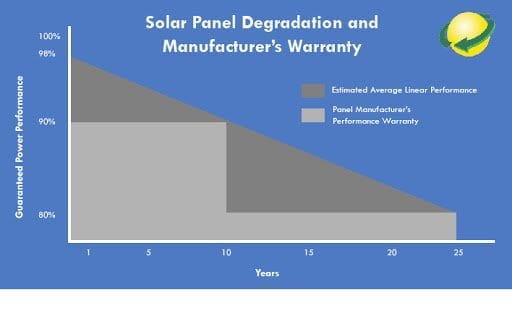The price decreases over the past ten years are a major reason why homeowners are increasingly interested in installing solar panels.
Why do solar panels lose efficiency over time.
Over time solar panels lose their ability to absorb sunlight and convert it into solar energy due to factors such as hotter weather and the natural reduction in chemical potency within the panel.
This is what is referred to as the degradation rate.
It s because they degrade rapidly in their first few hours.
Use the solar panel s warranty to compare output loss over time because that is the only output you are guaranteed.
When homeowners ask about efficiency however they usually mean solar panel performance over time.
Solar panel efficiency is a measurement of how much of the sun s energy a certain panel can convert into usable electricity.
What is known is that sodium enrichment occurs between the chemicals used on the surface of the solar cell and the glass in certain circumstances causing a leakage of current between the cells and the solar panel frame.
At the other extreme panels in desert climates exhibited large decreases in production over time close to 1 per year mainly due to high levels of uv exposure.
The efficiency of the solar cells used in a photovoltaic system in combination with latitude and climate determines the annual energy output of the system for example a solar panel with 20 efficiency and an area of 1 m 2 will produce 200.
The reason why they allow for extra degradation early on is not because panels degrade rapidly in their first year.
Changes in solar panel cost over time can be explained by swanson s law which states that the price of solar pv modules decreases by about 20 percent for every doubling in global solar capacity the law is named after richard swanson founder of high.
One solar panel from 1979 was tested in 2010 after 30 years and its output was better than the.
It may seem counter intuitive but solar panel efficiency is affected negatively by temperature increases.
Light induced degradation or lid affects most solar panels and reduces their efficiency by 1 3 during the first few hours they are exposed to sunlight.
Let s take a quick look at why and why accurately predicting your solar system s performance over time requires more accurate measures.
Panels in more moderate climates such as the northern united states had degradation rates as low as 0 2 per year.
This is done by capturing the electrical current generated when sunshine interacts with the solar cells in the panel and is transferred through the wiring and busbars to be converted into ac alternating current energy.
Realistically expect less than a 3 decrease in output the first year and about 5 decrease per year after that for most panels.
Solar cell efficiency refers to the portion of energy in the form of sunlight that can be converted via photovoltaics into electricity by the solar cell.
One rule of thumb is that solar panels lose 1 of their electricity generating capacity every year.









